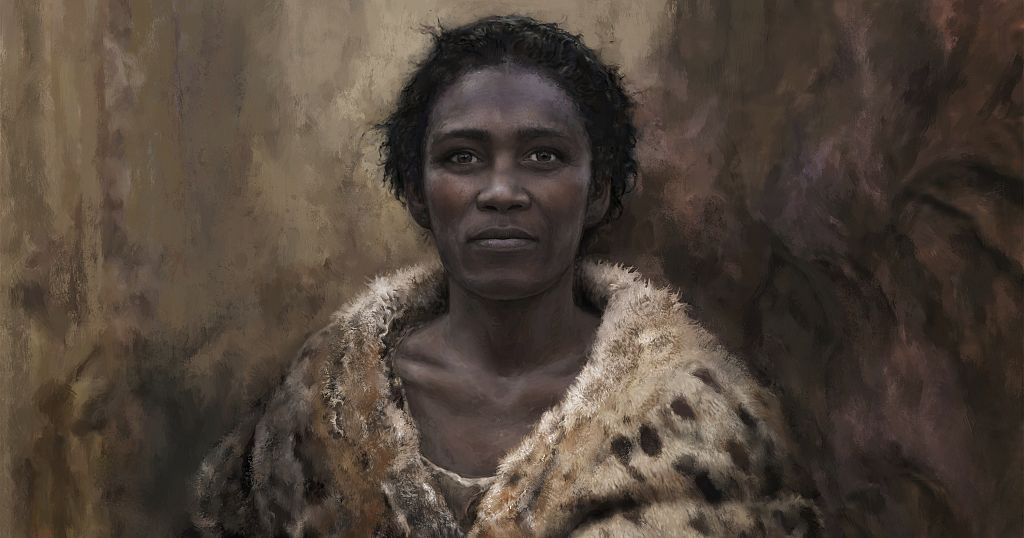Ancient genes show human-Neanderthal mingling 45,000 years ago

This is the image based on detailed research of the oldest known modern human that settled in Europe from Africa.
It’s the first time scientists in Germany have released their depiction of Zlatý kůň woman.
Studies of DNA – the oldest ever recovered from early humans – created her with dark skin, dark eyes and dark hair.
According to research just published in the Science and Nature journals, she and a small number of groups arrived in Europe 45,000 years ago.
They were distinct from the Neanderthals with whom they briefly mixed.
These modern humans mixed with Neanderthals but their progeny did not survive according to one of the lead researchers at the Max Planck Institute for Evolutionary Anthropology in Leipzig.
While the genes of Neanderthals have endured through successive generations, theirs has not according to Dr Kay Prüfer, the group leader at Max-Planck.
“This is this a lineage that is kind of the earliest split of people that lived outside of Africa, so this is an early excursion into Europe and one of the earliest splits from this common population that gave rise to all the different populations that we have now spread all over the world outside Africa,” he says.
Scientists say they were surprised to discover the DNA from Zlatý kůň woman excavated from a cave in the Czech Republic in 1950 was a part of the same extended family identified from bones found in Ranis, Germany over two decades earlier.
Prüfer says: “When you think about it all people outside of Africa have a little bit of Neanderthal DNA in their genomes and this Neanderthal DNA originates from this admixture. And in order to for this to happen, they must have been in some population that, essentially started mixing with Neanderthals and then started mixing with one another so that everyone gets a little bit of Neanderthal ancestry. And so it essentially means that this particular date is the date we are all of the ancestry of present day Non-africans ends up in the same population. This is our ancestral population and all of our ancestors were still together in one coherent population.”
Prüfer concludes this small pioneering population from Africa left no decendents.
“So it seems that this lineage essentially went extinct, so this first excursion into Europe didn’t leave any detectable ancestry in later, modern humans that live outside of Africa. So this is the first thing, the other thing that we can do with the genomes and how they are related is to get a bit of an idea of how many individuals they are really composing this group of Ranis and Zlatý kůň, and so we estimated this group consists of maybe 200 to 300 people, individuals,” he says.
It’s a glimpse into the lives of a small group of people, the earliest modern humans, who mixed and had children with Neanderthals, but whose generations petered out.
They would have been distinct from earlier arrivals according to Prüfer.
He says: “For those individuals we have studied here Zlatý kůň and Ranis that lived in Germany and the Czech Republic 45,000 years ago, we actually see that they carried the same alleles (DNA sequences) that would make up individuals with a dark skin colour, dark eyes and dark hair colour. So they essentially looked African to the degree that we can determine this. And this makes a lot of sense since they just left that continent.”
Why the descendants didn’t thrive and survive is still puzzling scientists.
“One of the mysteries we are trying to solve is why is it there is this difference? So did they not have the chance to meet Neanderthals? Is it that Neanderthals avoided sort of the territory where they lived, or did they actually take different routes into Europe that might have actually prevented them to meet Neanderthals?” Prüfer says.
He is encouraged to discover more, especially as a separate group of researchers, using different scientific methods come to the same conclusions in today’s Science journal.
“They did not actually include our data, so these two studies are independent in this respect, so we are not using the same data to find the same things and this means that it is quite nice that we end up in the same ball park with our estimates, right? so it’s a sort of independently found evidence for this population that lived around this time frame,” says Prüfer.
Source: Africanews














